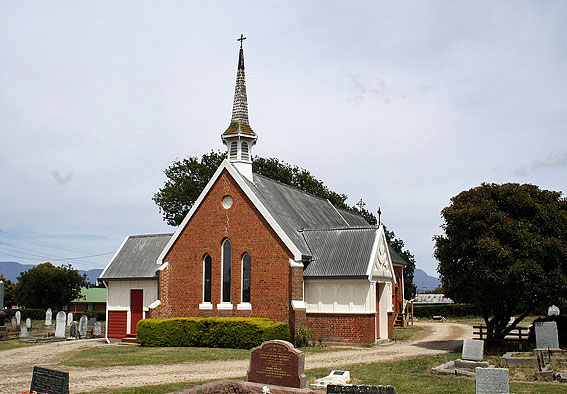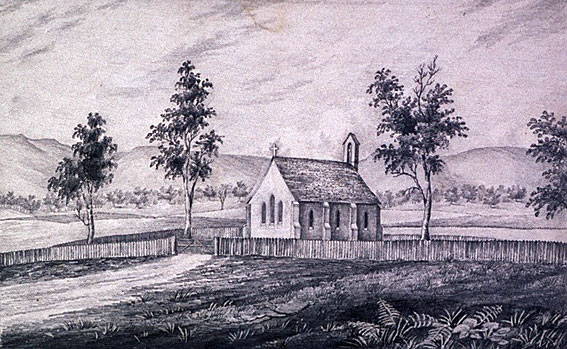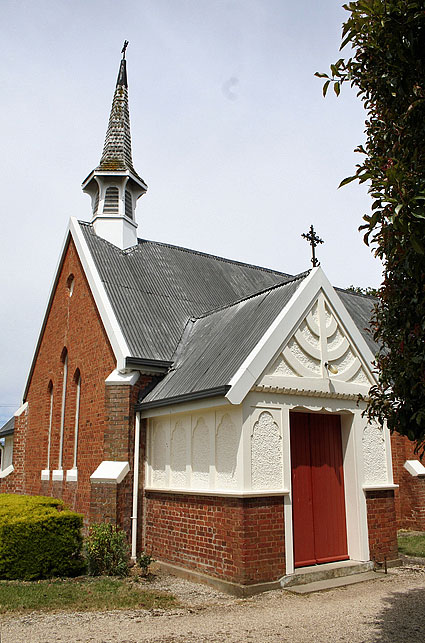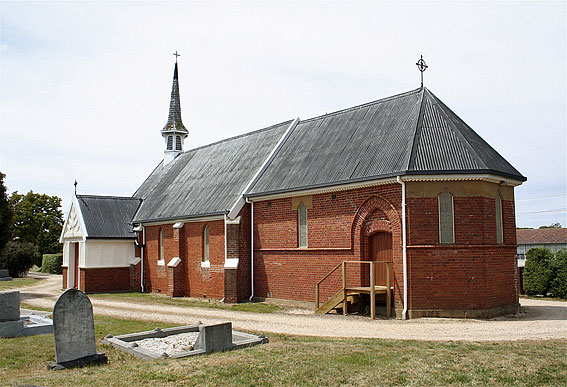
Holy Trinity Anglican Church
[Photograph by Trevor Bunning (December 2008)]

Holy Trinity Anglican Church
[Photograph by Trevor Bunning (December 2008)]
Historical and Technical Documentation by David Shield
© OHTA 2012 (last updated July 2012)
The organ at Holy Trinity was listed amongst the gifts to the church at its reopening in 1894. An early church constructed between 1838 and 1844, consecrated by Bishop Nixon, was replaced by one built for J D Toosey in 1858. By 1889 this church longer suited the requirements of the congregation. Although a new building was mooted, compromise saw designs for enlargement by architects Corrie and North of Launceston, carried out by Messrs J & T Gunn in 1894.

Line drawing of original church, attributed to Emily Stuart Bowring, unsigned undated.
State Library of Tasmania [AUTAS 001124065863w800].1
The rebuilding took four months, Bishop Montgomery reopening the church for divine worship on Wednesday 1 August 1894. The alterations were inspected before the service by a large number of visitors and outlined in the press:
These consist of a brick porch, situate at the north-eastern corner of the building--the original entrance having been at the western end of the church--having a framing of pine to represent the seven golden candlesticks of the churches of Asia. The belfry is of oregon pine, and stands 20ft above the roof of the church, and is octagonally shaped, and is covered with Huon pine shingles. Above this again is a neat ironwork finial seven feet high, the whole building presenting a neat and finished appearance. The bill, [sic. for bell] which formerly belonged to one of the ships of the East Indian Company, bears the inscription " Sara Christiana, July 14, 1798." It afterwards belonged to the Cressy Company, and was subsequently presented to the church by the late Mr J. D. Toosey; it is enclosed in louvre frames. The old portion of the church has been re-plastered, the ceiling lined with Tasmanian hardwood, and a dado of the same material with a blackwood capping round the nave, chancel, and vestry, the whole of the interior woodwork being stained a suitable colour. A new facia board and spouting, relieved by dental [sic for dentil] moulding, has been placed round the building and adds greatly to the appearance. The entrance to the chancel is surmounted by a handsome arch, the floor being raised 2ft above that of the nave. The chancel rails are of polished blackwood, supported by hansome wrought iron standards. The portion separating the chancel from the vestry is of hardwood covered with a dossel of rich crimson velvet; the windows in the vestry and chancel are of stained cathedral glass, and the building will be lighted at night by a number of Rochester lamps. The dimensions of the church now are chancel and vestry 29ft by 141ft, and of the nave 35ft by 19ft, and it is ventilated by four of Tobin's improved ventilators.2


Holy Trinity Church Cressy, showing 1894 exetensions
[Photographs Trevor Bunning (December 2008)]

Interior of church prior to organ's removal to nave
[Photograph from original in church (undated)]
The furnishing of the church was not complete. A new pulpit, lectern and windows were intended. The pipe organ given by W H D Archer, was not immediately installed.
Miss Norman, daughter of the incumbent, was organist for the opening services.3 The instrument used is unknown. It has been said the organ came from "Panshanger", the residence of Joseph Archer.4 This is possible but unlikely. The evidence suggests it came much later by a more indirect route. It may be accepted that Joseph purchased a pipe organ from J C Bishop in 1837 when visiting England, although there is no mention of an imported organ in the ship's manifest on his return.5 His death in 18536 does not preclude his wife gifting the organ to the church from the estate in 1858, she certainly subscribed financially to the new church. As he had no heir Joseph bequeathed "Panshanger' to his nephew, son of Thomas, also named Joseph. If the organ remained in the house the younger Mrs Joseph Archer could have donated the instrument. However, verification is difficult and does not accord with known facts. There seems to be no media record of Holy Trinity's consecration in May of 1858 where the gifts to the church might have been recognised. Media reports clearly indicate the current organ came from a different branch of the family in 1896.
Joseph was the youngest of four brothers who arrived early in the nineteenth Century. Thomas had arrived in 1813. Joseph came in 1821 and was followed by William with their father in 1827, and finally Edward in 1833. All settled on large estates on the Norfolk Plains around Longford. The principal estate of Thomas was "Woolmers". Joseph owned "Panshanger", William "Brickendon" and Edward "Northbury". As already indicated Joseph died in 1853. His wife returned to England and remarried. His brother Thomas predeceased him and Edward was to follow in 1862 with William in 1876. Clearly the organ was donated by a member of the second generation.
William Henry Davies Archer was born in 1836, grandson of William Archer of "Brickendon". The organ was built by J C Bishop of Lisson Grove South, Mary Le Bone, London, clearly identified on the nameplate. It has been identified as being built in 1837.7 As his uncle was in London at the time it is reasonable to assume it was he who ordered the organ whether on his own account or for his brother William is not clear. Whichever branch of the family it originated from, the organ, offered in 1894 to Holy Trinity, is attributed to W H D Archer.

Bishop Nameplate
[Photograph by Trevor Bunning (December 2008)]
The organ was only installed in 1896. Eighteeen months previously the incumbent and church wardens had deemed it expedient not to have the instrument erected until the church was put in a thorough state of repair. At the harvest thanksgiving service in April 1896 it was mentioned that Mr John Owen of Longford was "busily engaged in erecting the pipe organ" It was used for the first time on Sunday 10 May described as "a beautifully compact one" with the rich quality of the tone" delighting all concerned, organist choir and congregation. Its value was put at considerably over £100 and they were deeply grateful to Mr W H D Archer for his munificent gift.8

1837 Bishop Organ, Holy Trinity Church Cressy
[Photograph by Trevor Bunning (December 2008)]
SPECIFICATION
| MANUAL Open Diapason Bass Open Diapason Treble Stopt Diapason Dulciana Bass Dulciana Treble Principal Hautboy [Flute 4] |
8 8 8 8 8 4 8 |
GG-TF# TG GG-TB mid. C |
Pedal pulldowns GG-TG
5 composition pedals
trigger swell lever
mechanical action
hand or foot blowing
The original short compass Hautboy has been replaced by a Flute 4. The casework is in polished mahogany, with a cloth panel in the front rather than the more usual dummy pipes, this being flanked by two columns with brass collars, all in a Regency style. The manual and pedals are retractable, to save space in a domestic context.

Stop knobs, Hautboy and Principal
[Photograph by Trevor Bunning (December 2008)]
1 annotated on the sketch is reference to two marriages. The first is to "Charlie and Mary"; the second in a different hand is for Septimus and Elvie." These are Charles Nicholls to Mary Cowie (Examiner 22/7/1858) and their son Septimus Nicholls to Elvira Smith (Examiner Mon 25/2/1895).
2 Examiner Thurs 2/8/1894 3.5/6
3 ibid
4 Clark & Johnson, Pipe Organs of Tasmania third Edition 2002
5 the family left for England in January 1835 (Launceston Advertiser Thurs 26/2/1835 p2), returning in May 1840 (Hobart Town Courier Fri 20/5/1840 p2). The organ is dated from 1837, see Elvin L. Bishop & Son Organbuilders p109. List of Imports from the Emu, Courier Fri 27/3/1840 p4
6 Examiner Tues 28/6/1853 p5
7 Elvin L op.cit
8 Examiner 14/5/1896 p5; Mercury Thurs 14 /5/ 1896 p3]